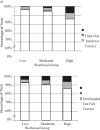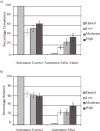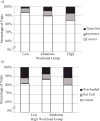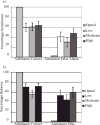Understanding the effect of workload on automation use for younger and older adults
- PMID: 22235529
- PMCID: PMC5816343
- DOI: 10.1177/0018720811421909
Understanding the effect of workload on automation use for younger and older adults
Abstract
Objective: This study examined how individuals, younger and older, interacted with an imperfect automated system. The impact of workload on performance and automation use was also investigated.
Background: Automation is used in situations characterized by varying levels of workload. As automated systems spread to domains such as transportation and the home, a diverse population of users will interact with automation. Research is needed to understand how different segments of the population use automation.
Method: Workload was systematically manipulated to create three levels (low, moderate, high) in a dual-task scenario in which participants interacted with a 70% reliable automated aid. Two experiments were conducted to assess automation use for younger and older adults.
Results: Both younger and older adults relied on the automation more than they complied with it. Among younger adults, high workload led to poorer performance and higher compliance, even when that compliance was detrimental. Older adults' performance was negatively affected by workload, but their compliance and reliance were unaffected.
Conclusion: Younger and older adults were both able to use and double-check an imperfect automated system. Workload affected how younger adults complied with automation, particularly with regard to detecting automation false alarms. Older adults tended to comply and rely at fairly high rates overall, and this did not change with increased workload.
Application: Training programs for imperfect automated systems should vary workload and provide feedback about error types, and strategies for identifying errors. The ability to identify automation errors varies across individuals, thereby necessitating training.
Figures







Similar articles
-
Automation reliability in unmanned aerial vehicle control: a reliance-compliance model of automation dependence in high workload.Hum Factors. 2006 Fall;48(3):474-86. doi: 10.1518/001872006778606822. Hum Factors. 2006. PMID: 17063963
-
The role of automation etiquette and task-criticality on performance, workload, automation reliance, and user confidence.Appl Ergon. 2025 May;125:104430. doi: 10.1016/j.apergo.2024.104430. Epub 2024 Dec 4. Appl Ergon. 2025. PMID: 39637736
-
Effects of Task Difficulty and Display Format on Automation Usage Strategy: A Workload Capacity Analysis.Hum Factors. 2018 Jun;60(4):527-537. doi: 10.1177/0018720818759356. Epub 2018 Feb 22. Hum Factors. 2018. PMID: 29470135
-
Adaptable (Not Adaptive) Automation: Forefront of Human-Automation Teaming.Hum Factors. 2022 Mar;64(2):269-277. doi: 10.1177/00187208211037457. Epub 2021 Aug 26. Hum Factors. 2022. PMID: 34435537 Review.
-
Agent Transparency, Situation Awareness, Mental Workload, and Operator Performance: A Systematic Literature Review.Hum Factors. 2024 Jan;66(1):180-208. doi: 10.1177/00187208221077804. Epub 2022 Mar 11. Hum Factors. 2024. PMID: 35274577 Free PMC article.
Cited by
-
Beyond Binary Decisions: Evaluating the Effects of AI Error Type on Trust and Performance in AI-Assisted Tasks.Hum Factors. 2025 Mar 19:187208251326795. doi: 10.1177/00187208251326795. Online ahead of print. Hum Factors. 2025. PMID: 40104968 Free PMC article.
-
Attitudes Toward Computers Across Adulthood From 1994 to 2013.Gerontologist. 2019 Jan 9;59(1):22-33. doi: 10.1093/geront/gny081. Gerontologist. 2019. PMID: 29982458 Free PMC article.
-
Effects of an Unexpected and Expected Event on Older Adults' Autonomic Arousal and Eye Fixations During Autonomous Driving.Front Psychol. 2020 Sep 18;11:571961. doi: 10.3389/fpsyg.2020.571961. eCollection 2020. Front Psychol. 2020. PMID: 33071906 Free PMC article.
-
Toward Quantifying Trust Dynamics: How People Adjust Their Trust After Moment-to-Moment Interaction With Automation.Hum Factors. 2023 Aug;65(5):862-878. doi: 10.1177/00187208211034716. Epub 2021 Aug 29. Hum Factors. 2023. PMID: 34459266 Free PMC article.
-
Effects of Trust, Self-Confidence, and Feedback on the Use of Decision Automation.Front Psychol. 2019 Mar 12;10:519. doi: 10.3389/fpsyg.2019.00519. eCollection 2019. Front Psychol. 2019. PMID: 30915005 Free PMC article.
References
-
- Craik FIM, Salthouse TA, editors. The handbook of aging and cognition. 2nd. Mahwah, NJ: Lawrence Erlbaum; 2000.
-
- Dixon SR, Wickens CD. Automation reliability in unmanned aerial vehicle control: A reliance-compliance model of automation dependence in high workload. Human Factors. 2006;48:474–486. - PubMed
-
- Dixon SR, Wickens CD, Chang D. Mission control of multiple unmanned aerial vehicles: A workload analysis. Human Factors. 2005;47:479–487. - PubMed
-
- Dixon SR, Wickens CD, McCarley JS. On the independence of compliance and reliance: Are automation false alarms worse than misses? Human Factors. 2007;49:564–572. - PubMed
-
- Hart SG, Staveland LE. Development of NASATLX (task workload index): Results of empirical and theoretical research. In: Hancock PA, Meshkati N, editors. Human mental workload. Amsterdam, Netherlands: Elsevier; 1988. pp. 139–183.
Publication types
MeSH terms
Grants and funding
LinkOut - more resources
Full Text Sources
Research Materials

